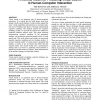Free Online Productivity Tools
i2Speak
i2Symbol
i2OCR
iTex2Img
iWeb2Print
iWeb2Shot
i2Type
iPdf2Split
iPdf2Merge
i2Bopomofo
i2Arabic
i2Style
i2Image
i2PDF
iLatex2Rtf
Sci2ools
CHI
2007
ACM
2007
ACM
A minimal model for predicting visual search in human-computer interaction
Visual search is an important part of human-computer interaction. It is critical that we build theory about how people visually search displays in order to better support the users' visual capabilities and limitations in everyday tasks. One way of building such theory is through computational cognitive modeling. The ultimate promise for cognitive modeling in HCI it to provide the science base needed for predictive interface analysis tools. This paper discusses computational cognitive modeling of the perceptual, strategic, and oculomotor processes people used in a visual search task. This work refines and rounds out previously reported cognitive modeling and eye tracking analysis. A revised "minimal model" of visual search is presented that explains a variety of eye movement data better than the original model. The revised model uses a parsimonious strategy that is not tied to a particular visual structure or feature beyond the location of objects. Three characteristics ...
CHI 2007 | Computational Cognitive Modeling | Human Computer Interaction | Keywords Visual Search | Visual Search Task |
| Added | 30 Nov 2009 |
| Updated | 30 Nov 2009 |
| Type | Conference |
| Year | 2007 |
| Where | CHI |
| Authors | Tim Halverson, Anthony J. Hornof |
Comments (0)

